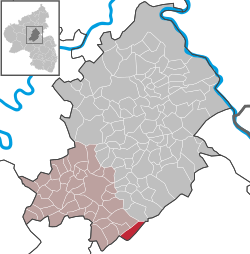Henau
| Henau | ||
|---|---|---|
|
||
| Coordinates: 49°52′09″N 7°29′59″E / 49.86917°N 7.49972°ECoordinates: 49°52′09″N 7°29′59″E / 49.86917°N 7.49972°E | ||
| Country | Germany | |
| State | Rhineland-Palatinate | |
| District | Rhein-Hunsrück-Kreis | |
| Municipal assoc. | Kirchberg | |
| Government | ||
| • Mayor | Hermann Kilz | |
| Area | ||
| • Total | 6.70 km2 (2.59 sq mi) | |
| Elevation | 400 m (1,300 ft) | |
| Population (2015-12-31) | ||
| • Total | 143 | |
| • Density | 21/km2 (55/sq mi) | |
| Time zone | CET/CEST (UTC+1/+2) | |
| Postal codes | 55490 | |
| Dialling codes | 06765 | |
| Vehicle registration | SIM | |
Henau is an Ortsgemeinde – a municipality belonging to a Verbandsgemeinde, a kind of collective municipality – in the Rhein-Hunsrück-Kreis (district) in Rhineland-Palatinate, Germany. It belongs to the Verbandsgemeinde of Kirchberg, whose seat is in the like-named town.
The municipality lies on the western edge of the Soonwald, a heavily wooded section of the west-central Hunsrück, at an elevation of 400 m above sea level, above the Kellenbach.
Bearing witness to Henau’s very early history are a stone hammer and a loom weight unearthed within the municipality’s limits. These are now kept at the Hunsrückmuseum in Simmern.
In 1316, Henau had its first documentary mention in a document from Count Simon II of Sponheim. The Koppenstein Castle ruin, found within the municipality’s limits, held town rights beginning in 1330, but had fallen into disrepair by the 16th century. Beginning in 1794, Henau lay under French rule. In 1815 it was assigned to the Kingdom of Prussia at the Congress of Vienna. Since 1946, it has been part of the then newly founded state of Rhineland-Palatinate.
The council is made up of 6 council members, who were elected at the municipal election held on 7 June 2009, and the honorary mayor as chairman.
Henau’s mayor is Hermann Kilz jr., and his deputies are Helmut Becker and Rosemarie Ebert.
The German blazon reads: In geteiltem Schild oben in Grün ein schreitender, herschauender, rotbewehrter silberner Löwe (= schreitender Leopard), unten blau-golden geschacht, belegt mit einer silbernen Schnalle, besetzt mit roten Edelsteinen.
...
Wikipedia



